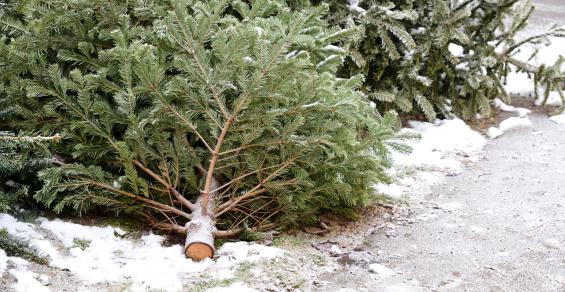What can I do to recycle or reuse my real Christmas tree after the holidays? Before taking your real Christmas tree down this year, consider using it outside to create a backyard habitat for birds.
To attract birds to your backyard, you must provide their three basic needs — food, water, and cover or shelter. Your old Christmas tree will provide excellent shelter for birds, providing protection from wind and predators. It can also serve as a feeding station, where you provide a buffet of food that native birds love.
Before taking the tree outside, remove all decorations and lights, including tinsel. To provide the most shelter possible for the birds, place the tree on the south or east side of the house, sheltered from winter’s harsh north and west winds.
Anchor the tree securely by setting the stump into the ground or a large bucket of damp sand, and secure the top of the tree with twine to a nearby building, fence or trees. Here are some things you can add to the tree:
“Decorations.” Decorate your tree with strings of popcorn, cranberries or raisins. Apples, oranges, leftover breads and pinecones covered with peanut butter — then dipped in birdseed — can also be added. For best results, push the edible ornaments well into the tree. Popcorn is attractive to cardinals, finches and grosbeaks. Cranberries and raisins attract cedar waxwings, finches and any robins wintering in the area.
Suet. Suet is especially attractive to insect-eaters such as woodpeckers, chickadees and nuthatches, and is a good winter energy source. Suet seed balls attract juncos, chickadees, finches and native sparrows.
Press suet into the branches or hang it in mesh bags, such as those used for onions and fruit in the supermarket. It is best to keep suet balls in the shade so they don’t melt. Also, keep them high enough in the tree that dogs can’t reach them. Premade mixtures, which include suet, bird seed and a variety of dried fruits, are available at most nurseries, garden centers, pet stores or bird supply stores.
To make your own suet seed balls, purchase suet from the meat department of your local grocery store. Mix birdseed and a small amount of peanut butter with suet while it’s warm enough to be molded. One seed combination that is attractive to a wide range of desirable songbirds is 50% sunflower seeds, 35% white proso millet and 15% finely cracked corn.
Mold the mixture around a wire hook, or fill empty orange rind halves with the suet mixture. Pierce two holes near the cut edge of the orange rind and thread a string through to make a hanger. Both the suet ball and orange rind halves can be hung in the tree.
If you decide to start feeding the birds, be consistent with your feeding. They become reliant on your feeders as a food source; empty feeders during a severe cold period or storm could result in the birds starving to death before they can find another food source.
Water. Even in winter, birds need water to drink and to keep their feathers clean. A birdbath with clean water will attract many birds if the water is not frozen. Commercial immersion heaters keep water from freezing. They are available from many nurseries or bird supply stores.
Providing for the winter needs of birds can result in many hours of entertainment, spent watching these beautiful creatures.
Other options. But if you don’t want to feed the birds, there are several other ways to put your old Christmas tree to good use. Again, remember to remove all lights, decorations and tinsel. Many communities collect trees to be chipped and used to cover walking paths, or as mulch for trees in city parks and arboreta. Check with your city offices to determine if this in an option.
Another recycling alternative for gardeners is to prune off the individual branches from the tree and place them over flower or strawberry beds as mulch. Finally, if you live on a farm or acreage, an old Christmas tree can be sunk into a pond or lake to create habitat for young fish.
If you have more questions, call Sarah Browning at 402-441-7180, or email [email protected].
Browning is a Nebraska Extension educator based in Lancaster County.
Farm and Garden: After Christmas, trees could still be of use as a bird feeder or as landscape mulch.




